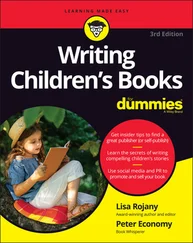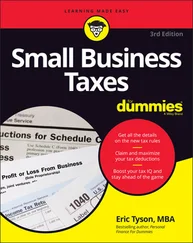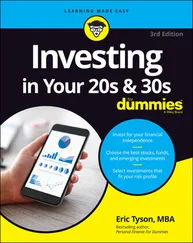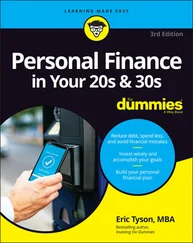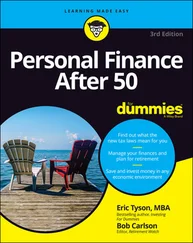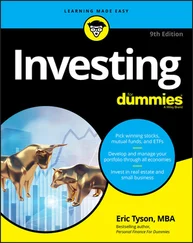 The future success of humanity is tied to figuring out how to achieve the ideas outlined in this book. If we’re going to be able to house, clothe, and feed a global population of 9 billion (and counting), we need new ideas and new approaches to making durable, reusable, and recyclable materials of tomorrow. This book can make that future possible.
The future success of humanity is tied to figuring out how to achieve the ideas outlined in this book. If we’re going to be able to house, clothe, and feed a global population of 9 billion (and counting), we need new ideas and new approaches to making durable, reusable, and recyclable materials of tomorrow. This book can make that future possible.
Whether your job is linked to manufacturing, design, or materials — or if you’re just a curious soul looking to make the world a better place — you’ll find Circular Economy For Dummies to be a fun, inspiring, and helpful guidebook on your journey.
Throughout the writing of this book, we had only you (our gentle reader) in mind. Don’t panic, but here’s the information we assumed about you so that you can get the maximum benefit from this book:
You’re seeking a comprehensive but condensed and easy-to-follow guide to implementing a circular economy strategy.
You’ve already heard about sustainability and you’re interested enough to buy this book.
You’re not a treehugger, but you’re concerned about climate change and waste.
You lack the time or patience for tracking down the meaning of unnecessary buzzwords or jargon — you want to get only the essential knowledge you need in order to get stuff done.
You recognize that the old “take-make-waste” approach to industrial manufacturing is less than perfect and that you might be able to find opportunities to save money and do the right thing at the same time.
You recognize that the field of circular economy is still a nascent and emerging topic and that, as more companies embrace these ideas, it will continue to evolve and change.
You realize that transforming and innovating a business requires careful planning and research.
You understand that this book is ultimately about people and the future of the planet.
Throughout this book, you see these little graphical icons to identify useful paragraphs:
 The Tip icon highlights expert advice and real-world experience to provide ways to save you time and money — and preserve your sanity!
The Tip icon highlights expert advice and real-world experience to provide ways to save you time and money — and preserve your sanity!
 The Remember icon marks information that’s so important you’ll want to remember it for later use. To grab the most important points in each chapter, just skim these paragraphs.
The Remember icon marks information that’s so important you’ll want to remember it for later use. To grab the most important points in each chapter, just skim these paragraphs.
 The Technical Stuff icon marks information that’s technically oriented but not critical to your understanding, so you can safely skip over them without harm.
The Technical Stuff icon marks information that’s technically oriented but not critical to your understanding, so you can safely skip over them without harm.
 The Warning icon highlights some sage advice to follow so that you can avoid costly mistakes or missteps. Warning: Don’t skip over these warnings!
The Warning icon highlights some sage advice to follow so that you can avoid costly mistakes or missteps. Warning: Don’t skip over these warnings!
How This Book Is Organized
This book is divided into six main parts — feel free to jump to any part you want. Each part is written in a way to tell you everything you need to know about a single topic inside each chapter. The following sections explain what you’ll find, and where:
Part 1: Linear Is Out, Circular Is In: An Economic Revolution
The early chapters in Part 1help you understand the problem behind the traditional approach to making products. It starts with an overview of the damage that industrial manufacturing has created and explains that it cannot continue in its current state. Then you’ll see how the circular economy has emerged as a new model that corrects these issues. Finally, you’ll read how the traditional approach compares to a circular approach in order to identify new ways to discuss and understand both approaches.
Part 2: Rethinking Business for a Circular Economy
In Part 2, you’ll look at business in a new way that will help you identify and uncover the issues in your current business approach. You’ll quickly understand how actions that you previously assumed were “just a part of doing business” (like creating waste and using toxic chemical processes) are actually costing you money. From there, you’ll find out how to structure a new business model based on simple pillars that will improve your relationship with your customers and your suppliers — and improve your profits. Think of this book as a crash course in strategic business planning for a new, circular world.
This part concludes with an extended look into waste products for what they really are — valuable resources to be reused.
Part 3: Rethinking Material Lifecycles — The Circular Perspective
In the chapters in Part 3, you discover the bold, new concept, called lifecycle, that will help you map and understand all aspects of your products. This becomes a foundational strategy that you can use to bend and convert those old, manufacturing pathways into circular loops of sustainable goodness.
You’ll see materials in an entirely new light and make better-informed decisions about sourcing, supplying, and processing materials. Part 3gives you a comprehensive list of case studies showing how dozens of companies are innovating their way to more profits.
The final chapter in Part 3explores how this all comes together to encompass the packaging and reuse of these materials.
Part 4: Redesigning the Future to Be Circular
The circular economy is looking toward the future. In Part 4, you get to see the vision of what a true circular design strategy looks like for food production, product design, architecture and construction, and fashion and clothing. You’ll be inspired and excited about the innovations to come with this circular future.
Each chapter in this part covers practical examples and steps you can apply immediately to your own work in these fields. You’ll discover what’s possible in the circular designs of tomorrow, such as shoes made from plastic waste that’s harvested from the ocean or alternative wall panels made from plants.
Part 5: Creating a Circular Economy for All
A true circular economy should be equitable, accessible, and available to everyone. In this part, you’ll read about the role that each individual person plays in making this future a reality, and you’ll discover the various career opportunities that await you. We close out Part 5with a big vision of a worldwide circular economy and what that might mean for everyone.
This wouldn’t be a For Dummies book without these handy lists of the top ten key discussion topics. The Part of Tens is a collection of important advice and suggestions about implementing a circular approach to materials, waste, and supply chains. We wrap up the book with the best questions to ask to help get you and your team thinking in innovative ways so that you can start putting these ideas into practice.
Although this book covers the essentials of the circular economy, there’s only so much that can be covered! You might reach the end of this book and find yourself thinking, “Gosh, that was incredible. Where can I learn more about the circular economy?” If that’s the case, head over to www.dummies.com for more resources.
Читать дальше
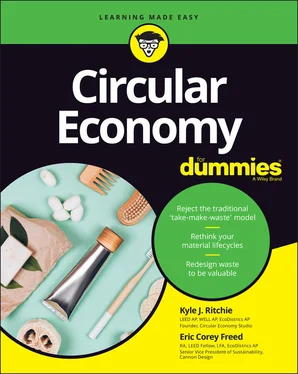
 The future success of humanity is tied to figuring out how to achieve the ideas outlined in this book. If we’re going to be able to house, clothe, and feed a global population of 9 billion (and counting), we need new ideas and new approaches to making durable, reusable, and recyclable materials of tomorrow. This book can make that future possible.
The future success of humanity is tied to figuring out how to achieve the ideas outlined in this book. If we’re going to be able to house, clothe, and feed a global population of 9 billion (and counting), we need new ideas and new approaches to making durable, reusable, and recyclable materials of tomorrow. This book can make that future possible. The Tip icon highlights expert advice and real-world experience to provide ways to save you time and money — and preserve your sanity!
The Tip icon highlights expert advice and real-world experience to provide ways to save you time and money — and preserve your sanity! The Technical Stuff icon marks information that’s technically oriented but not critical to your understanding, so you can safely skip over them without harm.
The Technical Stuff icon marks information that’s technically oriented but not critical to your understanding, so you can safely skip over them without harm. The Warning icon highlights some sage advice to follow so that you can avoid costly mistakes or missteps. Warning: Don’t skip over these warnings!
The Warning icon highlights some sage advice to follow so that you can avoid costly mistakes or missteps. Warning: Don’t skip over these warnings!
